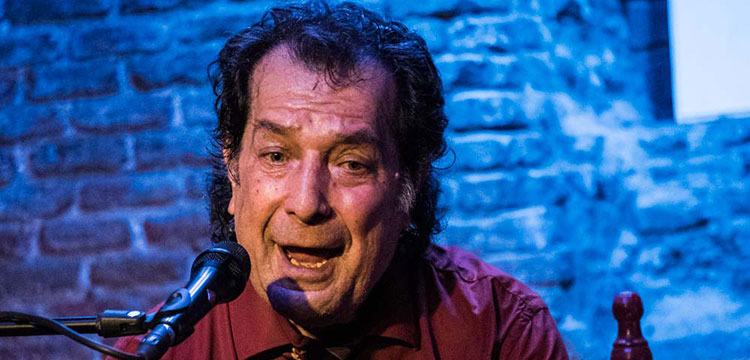José Manuel Gómez Gufi
Flamenco is an art of minorities, and we know this because we can identify fans who cheer the performers…and neither thing is easy, I mean, it’s not so easy to tell the difference, and it’s not easy to cheer in the right way. Madrid’s Círculo Flamenco is made up of a bunch of unrelenting flamenco followers who in recent years have been taken in at various locales until finally arriving at the OFF Latina venue, a cave in the heart of Madrid which feels like a clandestine speak-easy where alternative theater is worked. You know, those actors who seem to be doing weird things until they get lucky and the modern folk puff out their chests saying they saw so-and-so at that place.
Alberto Martínez presented the show: “We have two ‘analogical’ artists” he said, and pulled out two relics in the form of long-play records, adding: “Juan Villar and Niño Jero never went out of style”. And then you go to youtube and find that forty years ago when there was flamenco on Spanish television and Fernando Quiñones asked Camarón about “La Leyenda del Tiempo”, he devoted an entire program to Juan Villar. What would today’s directors of public television say about flamenco, the Spanish trademark, patriotism and bullfights? Ever since Camarón (and Juanito Villar), only two or three flamenco series have been programmed, and that’s no exaggeration, 13 chapters, jerks!
Guitarist Niño Jero “Periquín” started out trying the sound of his guitar, deconstructing tuning and variations. When the dodecaphonic alarms were touched off, he got into rhythm and the handclapping started.
-“You’re getting very deep” a good colleague told me, the kind that inform you and enjoy themselves. So the next time I’ll ask the person in question myself: “do you deconstruct, or what?”
Juan Villar presented himself with soleá, and sang the way people sing about things por soleá, as if his life depended on it, and Niño Jero accompanied as if he were saving the singer’s life, always in the right place, decorating the path along the way. Before the intermission, we reached the same path with bulerías, and a lot of people were anxious to comment on the recital that looked like it wasn’t going to have anything wishy-washy.
The Cádiz singer got underway with siguiriyas, having taken off his jacket, and it looked as if he’d run a marathon during the rest. Whatever cante he did, it was one of those things that takes this writer to another planet. A little like the Star Trek episode filmed in Cádiz bay with a strange mix of pain and beauty.
He sang tangos with an Arabic sound (if you’re thinking of something between Amina and El Lebrijano, no, it was a certain something I can’t put my finger on), that seemed to be a creation of his own. That’s when you have to go back and see Juan Villar on Spanish television and discover that he already had a sound of his own, a personal way of delivering flamenco singing.
This reviewer is not about to emit critical judgment until the polar caps melt (figure ten years or so). However, I do hope to be able to have the chance to hear Juan Villar and Niño Jero again because artists such as these, of that caliber, are neither common nor run-of-the-mill.
Fotos & videos @mj.lara.flamenco
